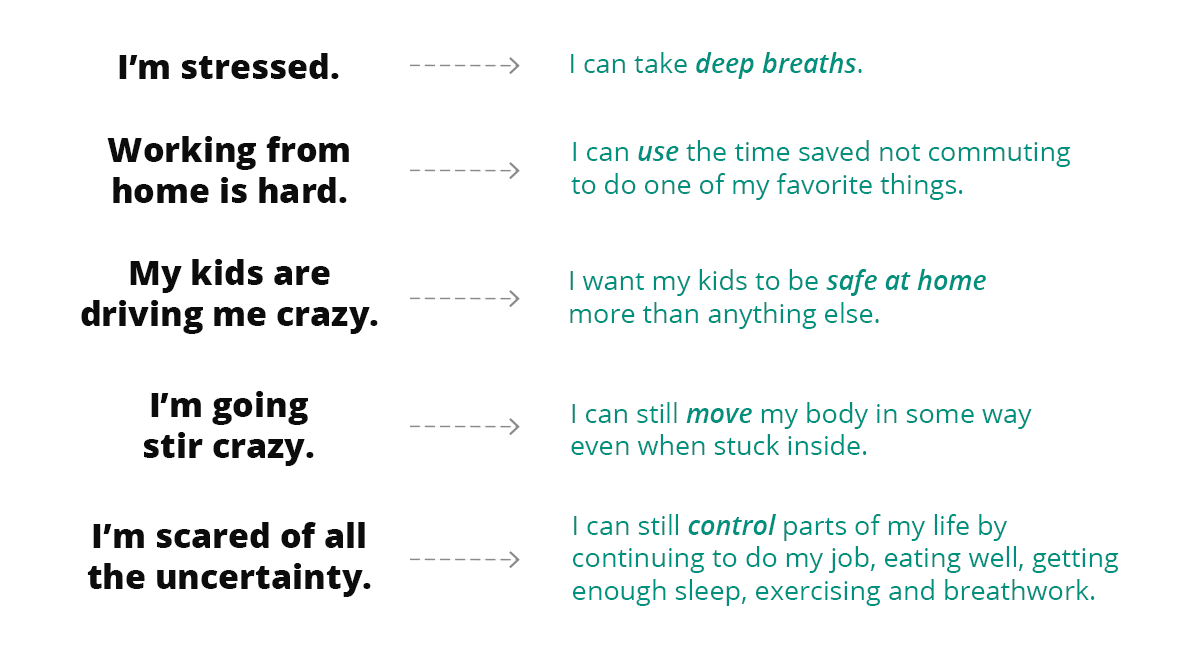How to Immediately Lower Your Stress During COVID-19
Feeling stressed out? Unmoored? Panicked?
Take a deep breath.
Remember, psychologists agree that heightened stress levels are normal. It is a global pandemic. But we’re going to get through this together.
We know battling coronavirus and working from home and keeping your kids occupied causes stress. How can it not?
So we gathered some techniques to help you lower your stress level right now. We’ve added a little bit of research behind each technique, but feel free to skip to the next one.
1. Deep Breaths
Inhale for five seconds and exhale for five seconds. Repeat until calm.
That’s one of the easiest, but any deep breathing technique will calm your nervous system. Or, you can connect with others virtually to meditate. Headspace is a popular meditation app to get you started.
Why does deep breathing calms you down?
Research shows deep breathing can reduce both acute and chronic stress and anxiety. Many therapists suggest using deep breathing techniques three times a day. Or whenever you’re feeling stressed, which might be often these days.
2. Focus on what you can control
Think about what choices you can make today. It’s easy to feel powerless, especially when many of us are confined to our homes.
Focus on the choices you do have:
- Binge watching Netflix or creating deeper relationships with our families?
- Spending hours on social media or learning something new?
- Cooking healthy meals or snacking all day long?
Those are just a few of the choices still in our power to make. Try thinking of others to add to the list.
Why do choices make us feel powerful?
Psychologists agree human beings are hardwired to make choices. They make us feel like we're in control. By focusing on what we can control, we send the message to our brains that we’re going to survive. The article above ended with this helpful saying:
Choices = Control = Survival
Extra tip for learning designers: Educational research shows choices can help motivate learners, too.
3. Shift Your Mindset
Ready to fight back against your worries with some new thoughts?
Lao Tzu was right when he said: “Watch your thoughts, they become your words; watch your words, they become your actions; watch your actions, they become your habits; watch your habits, they become your character; watch your character, it becomes your destiny.”
Let’s change our destiny right now by changing our negative thoughts into positive ones:
 This chart was inspired by a similar infographic created by motivational blogger, Sumaira Zaheer. Check it out here.
This chart was inspired by a similar infographic created by motivational blogger, Sumaira Zaheer. Check it out here.
What thoughts do you have that you need to change? Yours might not be the same. It’s just important you find a new thought to replace the old, negative ones.
Why does shifting our mindset work?
Our minds remain our most powerful tools for lowering our stress. Cognitive Behavioral Therapy rests on this important principle —We can train our minds to think new thoughts and conquer our fears.
Educators also use this technique when they encourage students to move from a fixed mindset to a growth mindset. Teachers encourage kids to talk back to any negative thoughts so “I make mistakes because I’m stupid” becomes “I can learn from my mistakes.” This change in thinking fuels student growth.
4. Make a schedule
Feel like your day at home is either passing too quickly or too slowly?
Maybe you’re never sure where you’re at. Are you behind? Ahead? Somewhere in the middle?
In our daily lives, we’re used to the triggers of going to work or taking a lunch break or getting coffee. These daily activities help our brains organize our lives. By staying at home all day, we remove many of the triggers for our daily habits. Remote workers have been dealing with this very issue for years.
How do remote workers get out of the pajamas and sit at their desks productively?
They make a schedule and build in new triggers like this one:
- Set a wake-up time
- Get dressed and eat breakfast.
- Schedule in time for breaks and exercise
- Eat lunch
- Stick to regular work hours
You might need timers or other artificial scheduling tools to help your brain learn the new schedule. Children also benefit from schedules.
What does the research say on creating new habits?
James Clear in his book, Atomic Habits, outlines a habit loop: trigger, craving, response and reward. So it makes sense that if you want to create a new habit, you need to find a trigger.
It can be difficult to find triggers when we’re working from home. Time triggers are probably the most effective, but you can also try changing your work location (even just one specific corner can make a difference) or reaching out to accountability buddies to help you stay productive.
We know a few techniques aren’t going to solve all of your problems. Nor, will they keep the stress at bay indefinitely. We just hope you get a chance to calm down for even a few minutes today. And most of all, please be kind to yourself and others in these exceptional circumstances.
We also know moving your learning programs online can add another layer of stress. Learn more about how BenchPrep's Quick Start Program equips you to maneuver around COVID-19 restrictions with a digital-first model with a fast tracked implementation.






